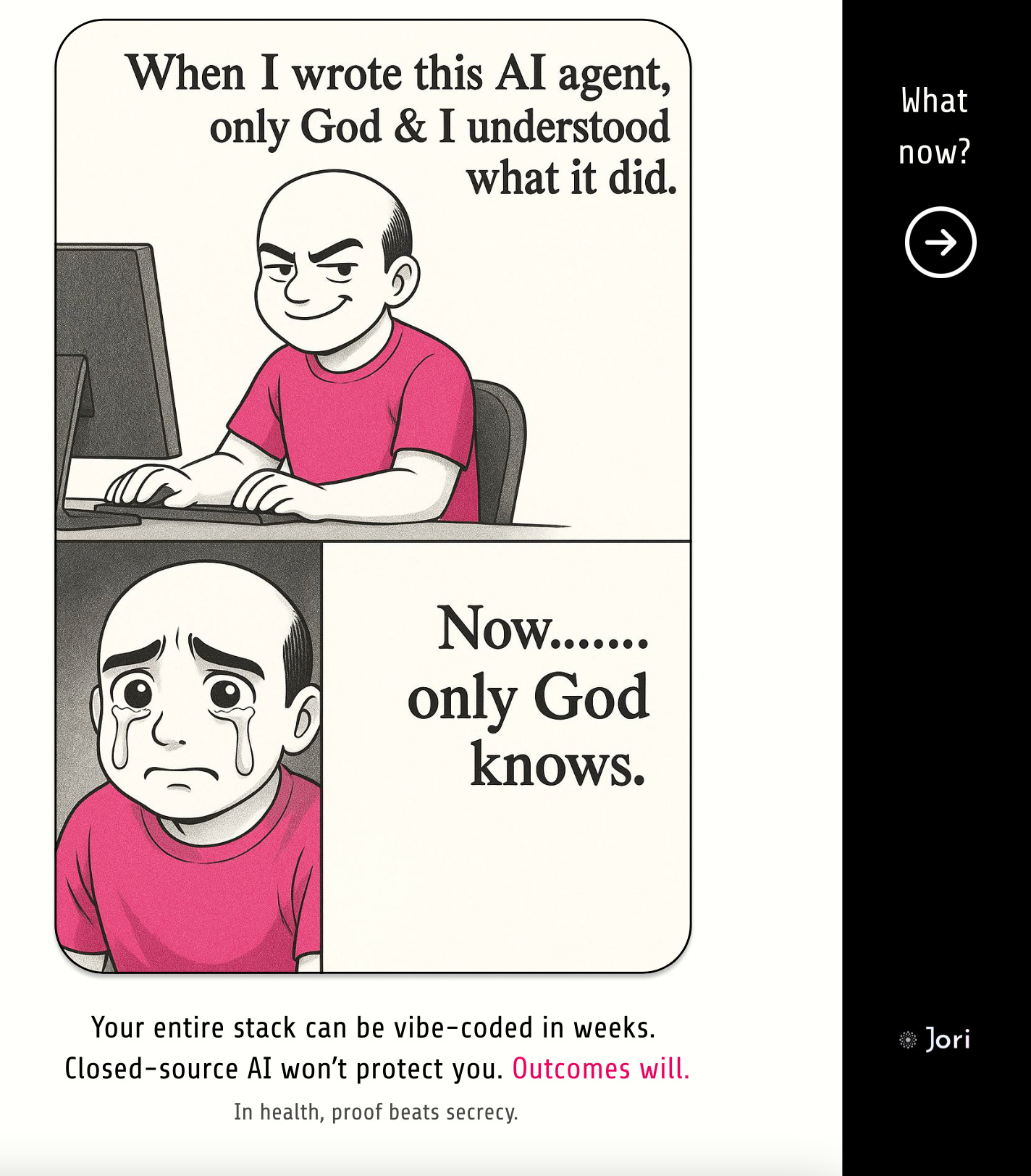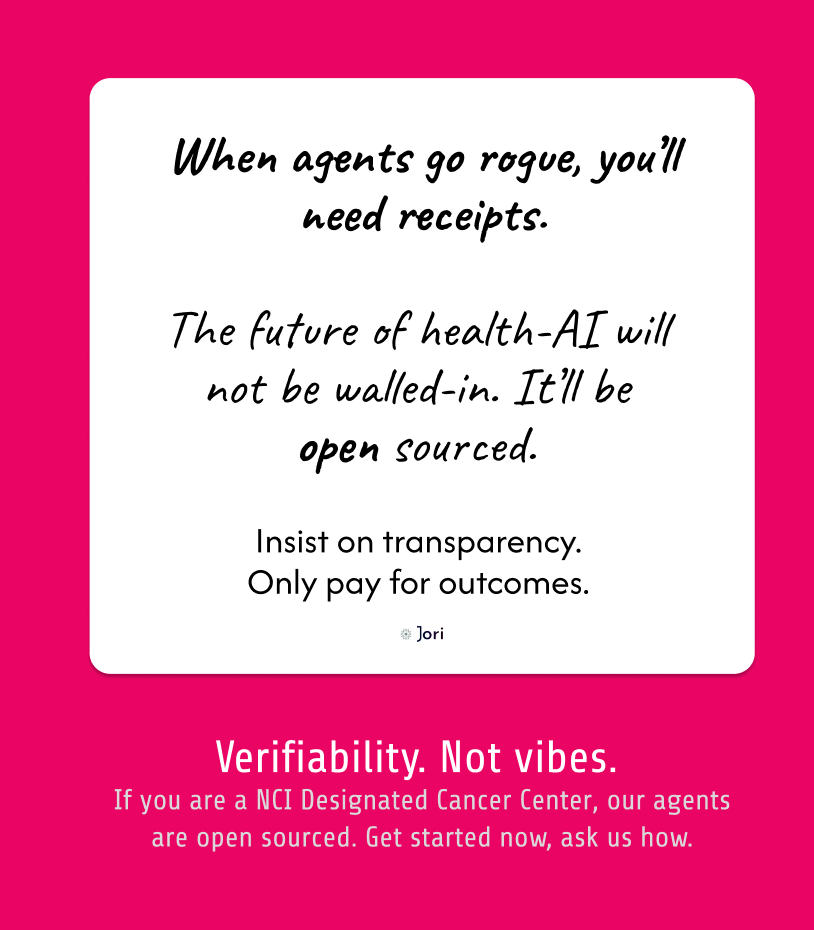Why Healthcare Can't Afford Black Box Medicine
Commodity AI will force healthcare to compete on what actually matters: trust.
💡Clinical intelligence will soon be as cheap as electricity. Provenance, transparency, and trust will become the new adoption metrics.
When every hospital can afford world-class AI, the differentiator won't be who has the smartest algorithms. It'll be who can prove their systems won't kill your patients.
We're living through the final days of expensive AI.
Within 2-4 years, clinical intelligence will be so cheap that community hospitals will run the same diagnostic models as MD Anderson.
Rural practices will have access to the same treatment optimization algorithms as Memorial Sloan Kettering. The barriers to entry are collapsing faster than anyone anticipated.
We’d know. We’re building one ourselves.
The question isn't whether this democratization will happen. It's what happens next?
The Commodity Collapse
In 1975, a basic calculator cost $395 (about $2,200 today). Now that same computational power is essentially free.
AI is following the same trajectory, but faster.
Training costs dropping 90% annually
Inference costs approaching zero
Open source models matching proprietary performance
Hardware commoditization accelerating deployment
Large language models that cost millions to train 24 months ago can now be fine-tuned on a laptop. Computer vision systems that required data centers now run on smartphones.
Translation: Your competitive moat isn't your algorithms anymore.
The Trust Arbitrage
In electricity, nobody cares about your generators. They care about reliability, safety, and service.
In healthcare AI, nobody will care about your model architecture. They'll care about provenance, transparency, and trust.
This shift is already beginning. Smart health systems aren't asking vendors "how accurate is your model?" They're asking "can you prove how this decision was made?" and "what happens when your system fails?"
The Three New Adoption Metrics
1. Provenance: The Audit Trail Revolution
In a world where every AI vendor claims 95%+ accuracy, provenance becomes the tie-breaker. Healthcare leaders want to know:
What data trained this model?
Who labeled the training examples?
How was bias testing conducted?
When was the model last updated?
The winners will be those who can provide forensic-level detail about their AI's lineage.
2. Transparency: Explainability as a Feature
When AI costs approach zero, the premium goes to systems that can explain themselves. Healthcare providers don't just want correct answers—they want to understand the reasoning.
When a radiologist can see exactly which image features drove a diagnosis, they're more likely to trust and act on the recommendation. When an oncologist understands why the system flagged a particular treatment, they're more likely to prescribe it.
Transparency becomes the ultimate user experience feature in commodity AI.
3. Trust: The Ultimate Competitive Advantage
Trust is the only moat that matters when intelligence becomes free. And trust in healthcare AI boils down to one question: "Will this system make me a better clinician or get me sued?"
Trust is earned through consistent performance, graceful handling of edge cases, clear communication of uncertainty, and rapid response to problems.
The Open Source Inevitability
Commodity markets favor open source solutions. When the underlying technology is essentially free, proprietary vendors can't justify premium pricing. Customers start asking "Why am I paying $100K annually for something my residents could build in a weekend?"
Open source wins on every dimension that matters in a commodity market:
Cost structure: No licensing fees, no vendor lock-in
Transparency: Full code access enables trust verification
Customization: Adapt to specific clinical workflows
Community: Shared responsibility for safety and improvement
The Outcome-Based Endgame
When clinical intelligence becomes free, billing models transform completely. You can't charge for access to something that costs nothing to provide.
The new economics:
Pay per correct diagnosis
Pay per successful treatment optimization
Pay per prevented adverse event
Pay per quality measure improvement
When vendors only get paid for measurable clinical outcomes, their incentives align perfectly with yours.
The NCI Designated Center Advantage
National Cancer Institute-designated cancer centers understand this transition. They've seen waves of "revolutionary" technologies come and go. They know that sustainable competitive advantage comes from clinical excellence, not technological exclusivity.
Which is why we're making our AI agents open source for NCI-designated centers. When intelligence becomes free, transparency becomes priceless.
Our approach:
Full source code access
Transparent training data and methodology
Real-time explainability
Outcome-based pricing
Preparing for the Transition
The shift from expensive AI to commodity intelligence will happen faster than most healthcare leaders expect.
Key questions to ask your AI vendors:
Can you provide complete provenance for your training data?
Will you commit to outcome-based pricing?
Can you explain every decision your system makes?
What happens to my data if your company gets acquired?
Key questions to ask yourself:
Are we building internal AI capabilities or just buying black boxes?
Do we have the infrastructure to verify AI decisions?
How will we compete when everyone has access to the same intelligence?
About Jori
We are precision oncology’s co-pilots. Our source code is free, our outcomes are not. Visit www.jori.health
When clinical intelligence becomes as cheap as electricity, the only question that matters is: who do you trust to keep the lights on?



